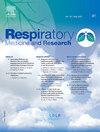The effect of concurrent acetylsalicylic acid on hemorrhagic complications during percutaneous image-guided lung biopsy
IF 1.8
4区 医学
Q3 RESPIRATORY SYSTEM
引用次数: 0
Abstract
Background
CT-guided trans-thoracic lung biopsy (CT-TTLB) is efficient and widely used to diagnose pulmonary nodules. After pneumothorax, the second most frequent complication is hemoptysis, which can be life-threatening. These patients often have comorbidities and are on acetylsalicylic-acid (ASA) therapy. The aim of this study was to assess ASA as a risk factor for hemoptysis or severe hemoptysis following CT-TTLB.
Methods
We retrospectively reviewed consecutive patients undergoing CT-TTLB from 2 centers between 01/2018 and 01/2021. Exclusion criteria were nodules with a pleural contact or a contraindication to lung puncture. Clinical and imaging data were recorded such as age, gender, comorbidities, hemoptysis (every blood spit), severe hemoptysis (>200 mL / oxygen need>10L/min / intervention or resuscitation / death), nodule size, puncture depth, emphysema, nodule location, patient position and histology. Lung parenchymal hemorrhage (LPH) was quantified in cm³ on CT after biopsy. Univariate and multivariate analysis were performed with a logistic regression model, without and with propensity match score, to identify variables associated with hemoptysis and severe hemoptysis.
Results
Four-hundred-and-one patients were analyzed, 106 and 295 in the ASA or the control group respectively. In multivariate analysis, ASA use was a risk factor for severe hemoptysis (OR=4.5; 95 %CI[1.3–15.9]) but not for hemoptysis (OR=1.7; 95 %CI[0.5–3.1]), persisting after matching. There was no difference for LPH between the ASA and the control sub-groups (median (IQR)) 5.2cm³ (15.3) vs 3.1cm³ (11.5) p = 0.2).
Conclusions
Treatment with ASA did not increase the risk of all hemoptysis occurrence after CT-TTLB but was a risk factor for severe hemoptysis.
并发乙酰水杨酸对经皮图像引导肺活检出血并发症的影响
背景ct引导下经胸肺活检(CT-TTLB)是诊断肺结节的有效且广泛的方法。排在气胸之后,第二常见的并发症是咯血,这可能危及生命。这些患者通常有合并症,并接受乙酰水杨酸(ASA)治疗。本研究的目的是评估ASA作为CT-TTLB后咯血或严重咯血的危险因素。方法回顾性分析2018年1月至2021年1月2个中心连续接受CT-TTLB的患者。排除标准为胸膜接触结节或肺穿刺禁忌症。记录年龄、性别、合并症、咯血(每次吐血)、重度咯血(需氧量200 mL /min /次干预或复苏/死亡)、结节大小、穿刺深度、肺气肿、结节位置、患者体位、组织学等临床及影像学资料。活检后CT定量肺实质出血(LPH),以cm³为单位。单因素和多因素分析采用逻辑回归模型,无倾向匹配评分和有倾向匹配评分,以确定与咯血和严重咯血相关的变量。结果共分析401例患者,ASA组106例,对照组295例。在多因素分析中,ASA的使用是严重咯血的危险因素(OR=4.5;95% CI[1.3-15.9]),但咯血无统计学意义(OR=1.7;95% CI[0.5-3.1]),匹配后持续。ASA组和对照组之间LPH无差异(中位数(IQR)) 5.2cm³(15.3)vs 3.1cm³(11.5)p = 0.2)。结论ASA治疗并没有增加CT-TTLB术后所有咯血的发生风险,但却是严重咯血的危险因素。
本文章由计算机程序翻译,如有差异,请以英文原文为准。
求助全文
约1分钟内获得全文
求助全文
来源期刊

Respiratory Medicine and Research
RESPIRATORY SYSTEM-
CiteScore
2.70
自引率
0.00%
发文量
82
审稿时长
50 days
 求助内容:
求助内容: 应助结果提醒方式:
应助结果提醒方式:


